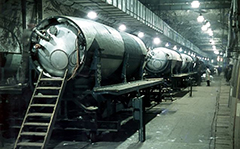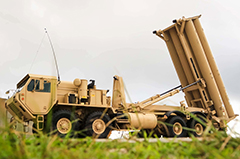1. Strategic Ballistic Missiles:
A ballistic missile follows a ballistic trajectory to deliver one or more warheads on a predetermined target. These weapons are only guided during relatively brief periods of flight—most of their trajectory is unpowered, being governed by gravity and air resistance if in the atmosphere. Shorter range ballistic missiles stay within the Earth's atmosphere, while longer-ranged intercontinental ballistic missiles (ICBMs), are launched on a sub-orbital flight trajectory and spend most of their flight out of the atmosphere. An intercontinental ballistic missile (ICBM) is a guided ballistic missile with a minimum range of 5,500 kilometres (3,400 mi) primarily designed for nuclear weapons delivery. More detailsThe V-2 was the world's first long-range guided ballistic missile. The missile, powered by a liquid-propellant rocket engine, was developed during the Second World War in Germany as a "vengeance weapon", assigned to attack Allied cities as retaliation for the Allied bombings against German cities. The V-2 rocket also became the first man-made object to travel into space by crossing the Kármán line with the vertical launch of MW 18014 on 20 June 1944. Research into military use of long range rockets began when the studies of graduate student Wernher von Braun attracted the attention of the German Army. A series of prototypes culminated in the A-4, which went to war as the V-2. More details
3. Titan II Missile:
The Titan II was an intercontinental ballistic missile (ICBM) and space launcher developed by the Glenn L. Martin Company from the earlier Titan I missile. Titan II was originally designed and used as an ICBM, but was later used as a medium-lift space launch vehicle to carry payloads for the United States Air Force (USAF), National Aeronautics and Space Administration (NASA) and National Oceanic and Atmospheric Administration (NOAA). Those payloads included the USAF Defense Meteorological Satellite Program (DMSP), the NOAA weather satellites, and NASA's Gemini manned space capsules. More details
4. Cruise Missile:
A cruise missile is a guided missile used against terrestrial targets that remains in the atmosphere and flies the major portion of its flight path at approximately constant speed. Cruise missiles are designed to deliver a large warhead over long distances with high precision. Modern cruise missiles are capable of travelling at supersonic or high subsonic speeds, are self-navigating, and are able to fly on a non-ballistic, extremely low-altitude trajectory. Cruise missiles generally consist of a guidance system, payload, and aircraft propulsion system, housed in an airframe with small wings and empennage for flight control. More details
5. TOW Anti Tank Missile:
The BGM-71 TOW ("Tube-launched, Optically tracked, Wire-guided") is an American anti-tank missile. TOW replaced much smaller missiles like the SS.10 and ENTAC, offering roughly twice the effective range, a more powerful warhead, and a greatly improved semi-automatic guidance system that could also be equipped with infrared cameras for night time use. First produced in 1970, the TOW is one of the most widely used anti-tank guided missiles. It can be found in a wide variety of manually carried and vehicle-mounted forms, as well as widespread use on helicopters. Originally designed by Hughes Aircraft in the 1960s, the weapon is currently produced by Raytheon. More details
6. Javelin Anti Tank Missile:
The FGM-148 Javelin is an American man-portable fire-and-forget anti-tank missile fielded to replace the M47 Dragon anti-tank missile in US service. It uses an automatic infrared guidance that allows the user to seek cover immediately after launch, as opposed to wired-guided systems, like the Dragon, where the user has to actively guide the weapon throughout the engagement. The Javelin's HEAT warhead is capable of defeating modern tanks by attacking them from above, and is also useful against fortifications in a direct attack flight. Javelin is a fire-and-forget missile with lock-on before launch and automatic self-guidance. More details
7. THAAD Defense System:
Terminal High Altitude Area Defense (THAAD), formerly Theater High Altitude Area Defense, is an American anti-ballistic missile defense system designed to shoot down short-, medium-, and intermediate-range ballistic missiles in their terminal phase (descent or reentry) by intercepting with a hit-to-kill approach. THAAD was developed after the experience of Iraq's Scud missile attacks during the Gulf War in 1991. The THAAD interceptor carries no warhead, but relies on its kinetic energy of impact to destroy the incoming missile. More details
8. Aegis Combat System:
The Aegis Combat System is an American integrated naval weapons system developed by the Missile and Surface Radar Division of RCA, and now produced by Lockheed Martin. It uses powerful computer and radar technology to track and guide weapons to destroy enemy targets. Initially used by the United States Navy, Aegis is now used also by the Japan Maritime Self-Defense Force, Spanish Navy, Royal Norwegian Navy, Republic of Korea Navy and Royal Australian Navy. Over 100 Aegis-equipped ships have been deployed. It is also part of NATO's European missile defence system. More details
9. Missile Moyenne Portée:
Missile Moyenne Portée (Medium-Range Missile) is a French man-portable anti-tank guided missile. It was developed by MBDA Missile Systems and is intended as a replacement for their MILAN, which has been sold worldwide. The Missile Moyenne Portée (MMP) was designed to overcome some of MILAN's limitations in the context of small-scale and counter-insurgency operations post-2000, rather than the Cold War tank war of the original MILAN requirement. In theatres such as Iraq and Afghanistan, man-portable missile were often used against strongpoints and improvised armour within populated areas. More details
The LGM-30 Minuteman is a U.S. land-based intercontinental ballistic missile (ICBM), in service with the Air Force Global Strike Command. As of 2018, the LGM-30G Minuteman III version[a] is the only land-based ICBM in service in the United States. Development of the Minuteman began in the mid-1950s and as the outgrowth of basic research into solid fuel rocket motors which indicated an ICBM based on solids was possible. Such a missile could stand ready for extended periods of time with little maintenance and then launch on command. More details
11. LGM-118 Peacekeeper Missile:
The LGM-118 Peacekeeper, also known as the MX missile (for Missile-eXperimental), was a land-based ICBM deployed by the United States starting in 1986. The Peacekeeper was a MIRV missile that could carry up to 10 re-entry vehicles, each armed with a 300-kiloton W87 warhead in a Mk.21 reentry vehicle (RV). A total of 500 missiles were deployed starting in 1986, after a long and contentious development program that traced its roots into the 1960s. MX was designed to allow the US to ride out a sneak attack by the Soviet ICBM fleet and then launch a counterattack. More details
12. The Man Who Saved The World:
Vasily Alexandrovich Arkhipov, (30 January 1926 – 19 August 1998) was a Soviet Navy officer credited with preventing a Soviet nuclear strike during the Cuban Missile Crisis. Such an attack likely would have caused a major global thermonuclear response. As flotilla commander and second-in-command of the diesel powered submarine B-59, Arkhipov refused to authorize the captain's use of nuclear torpedoes against the United States Navy, a decision requiring the agreement of all three senior officers aboard. In 2002, Thomas Blanton, who was then director of the US National Security Archive, said that Arkhipov "saved the world". More details
13. Cuban Missiles Crisis:
The Cuban Missile Crisis, also known as the October Crisis of 1962, the Caribbean Crisis, or the Missile Scare, was a 13-day (October 16–28, 1962) confrontation between the United States and the Soviet Union initiated by the American discovery of Soviet ballistic missile deployment in Cuba. The confrontation is often considered the closest the Cold War came to escalating into a full-scale nuclear war. In response to the failed Bay of Pigs Invasion of 1961 and the presence of American Jupiter ballistic missiles in Italy and Turkey, Soviet leader Nikita Khrushchev agreed to Cuba's request to place nuclear missiles on the island to deter a future invasion. More details
14. Atlas ICBM:
The SM-65 Atlas was the first operational intercontinental ballistic missile (ICBM) developed by the United States and the first member of the Atlas rocket family. It was built for the U.S. Air Force by the Convair Division of General Dynamics at an assembly plant located in Kearny Mesa (north of San Diego). Atlas became operational as an ICBM in October 1959 and was quickly obsoleted by new development, being retired as a missile by 1965. However, Atlas-derived launch vehicles have a long history as space launchers. Even before its ICBM use ended in 1965, Atlas had placed four Project Mercury astronauts in orbit and was becoming the foundation for a family of successful space launch vehicles, most notably Atlas Agena and Atlas Centaur. More details
15. FIM-92 Stinger Missile:
The FIM-92 Stinger is a Man-Portable Air-Defense System (MANPADS) that operates as an infrared homing surface-to-air missile (SAM). It can be adapted to fire from a wide variety of ground vehicles and helicopters (as an AAM). Developed in the United States, it entered service in 1981 and is used by the militaries of the United States and 29 other countries. It is principally manufactured by Raytheon Missile Systems and is produced under license by EADS in Germany and by Roketsan in Turkey, with 70,000 missiles produced. Light to carry and easy to operate, the FIM-92 Stinger is a passive surface-to-air missile that can be shoulder-fired by a single operator. More details
16. DF-41 Missile:
The DF-41 (Dongfeng-41) is a Chinese solid-fuelled road-mobile intercontinental ballistic missile. The missile, reportedly capable of reaching the US within 30 minutes, was officially unveiled at the October 2019 China Day military parade. The missile reportedly has an operational range between 12,000 km to 15,000 km. This would make it the world's longest range missile, surpassing the range of the US LGM-30 Minuteman, which has a reported range of 13,000 km. It is believed to have a top speed of Mach 25, and to be capable of MIRV delivery (up to 12). More details17. Chinese Ballistic Missiles:
China has the largest land-based missile arsenal in the world. According to Pentagon estimates, this includes 1,200 conventionally armed short-range ballistic missiles, two hundred to three hundred conventional medium-range ballistic missiles and an unknown number of conventional intermediate-range ballistic missiles, as well as two to three hundred ground-launched cruise missiles. Many of these are extremely accurate, which would allow them to destroy targets even without nuclear warheads. More details18. Anti Tank Weapons:
An anti-tank missile (ATM), anti-tank guided missile (ATGM), anti-tank guided weapon (ATGW) or anti-armor guided weapon, is a guided missile primarily designed to hit and destroy heavily armored military vehicles. ATGMs range in size from shoulder-launched weapons, which can be transported by a single soldier, to larger tripod-mounted weapons, which require a squad or team to transport and fire, to vehicle and aircraft mounted missile systems. The introduction to the modern battlefield of smaller, man-portable ATGMs with larger warheads has given infantry the ability to defeat light and medium tanks at great ranges. More details19. Hypersonic Missiles:
Two main types of hypersonic weapons are hypersonic cruise missiles and hypersonic glide vehicles. Hypersonic weapons, by definition, travel five or more times the speed of sound. Hypersonic cruise missiles, which are powered by scramjet, are restricted below 100,000 feet; hypersonic glide vehicles can travel higher. Compared to a ballistic (parabolic) trajectory, a hypersonic vehicle would be capable of large-angle deviations from a parabolic trajectory. According to CNBC, Russia and China lead in hypersonic weapon development, trailed by the United States. France, India, and Australia may also be pursuing the technology. Japan is acquiring both scramjet, and boost-glide weapons. More details



















